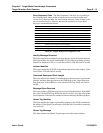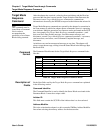
21020285 D User’s Guide
Chapter 6 Target Mode Pass-through Commands
Page 6 - 18 Target Mode Response Command
Note
As an example of how to
use the bits of the
Response Control Flags
field, suppose you wish
to check the data that the
RF3880 receives from
an initiator before
determining what action
to take. You could do the
following:
1. On the first Target
Mode Response
command, set bits 1 to 7
to zero—the adapter will
perform the requested
data transfer and then
hold the bus without
sending any messages.
2. After determining an
action, set bits 1 to 7 as
desired (to continue the
data transfer or terminate
the command) set the
CSC bit (bit 0), and issue
another Target Mode
Response command.
DSC Disconnect SCSI command termination - Use this bit when the
SCSI command is not yet complete and you wish to send another Target Mode
Response command. Use of this bit will cause the adapter to send the First
Message Byte (usually a Save Data Pointer message) followed by the Message
Byte, (usually a Disconnect message) and then go to Bus Free phase.
0 ⇒ This option will not be used.
1 ⇒ The adapter will go to Bus Free after sending the First Message Byte
followed by the Message Byte.
LSC Linked SCSI command termination - This bit is used to terminate
a linked SCSI command and begin receiving the next command. In this case,
the adapter will send the Status Byte followed by the Message Byte and then
go to Command Phase.
0 ⇒ This option will not be used.
1 ⇒ The adapter will go to Command phase after sending the Status Byte
followed by the Message Byte.
SMB Send Message Byte only - Use this bit to cause the adapter to send
the First Message Byte (often a Save Data Pointer message) to the initiator after
any data transfer is complete, and not go to Bus Free phase.
0 ⇒ This option will not be used.
1 ⇒ The adapter will send the First Message Byte and will not go to Bus Free
phase afterward.
Message Byte
Depending on the setting of the NSC or DSC bits of the Response Control Flags
field, this field will contain either a Message byte to send after the Status byte
(NSC is one), or the second Message byte to send (DSC is one).
Status or 1st Message Byte
Depending on the setting of the NSC and DSC bits of the Response Control
Flags field, this field will contain either a status byte (NSC is one), or the first
message byte to send (DSC is one).
Queue Tag Identifier
This byte contains the queue tag identifier assigned to this SCSI command by
the initiator.
Queue Tag Message
This byte contains a Simple Queue Tag message (20H) if any queue tag
message was received from the initiator.


















